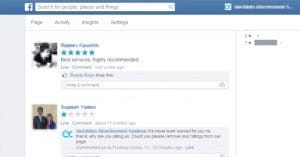 Written by ContentPowered.com
Written by ContentPowered.com![]()
There are a lot of reasons why a user might be irate at a business, and they very often come out in frustrated text posts. Some people have no filter, and some just don’t want to hide their feelings. You might end up with negative messages posted in your reviews or on your wall, either as stand-alone posts or as replies to your posts. How can you manage these to maintain your reputation without censoring your users?
You have three options for how to deal with any negative comment, no matter who it comes from or where it’s posted. These are to respond to the comment, to ignore it, or to remove it.
Step 1: Make Sure You See the Comment
You can’t respond to a comment you haven’t seen, and when you let a negative or profanity-laced comment sit for days or weeks without response, it looks as though you neglect your page administration. You need to keep an eye out for every comment left on your page. You can do the same thing with Twitter’s listen service, as well as Google Alerts for non-Facebook posts.
Step 2: Categorize Comments
When you receive a comment, file it away. Is it positive, neutral, or negative? Is it worth a response, is it fine to ignore, or should it be addressed?
There are a few considerations to make when dealing with off-side comments. They’re worth mentioning, so I’ll cover them here.
Occasionally, you’ll see criticism and negativity directed at your business, but it’s posted on a small niche blog with very few readers. When that happens, don’t worry about responding to it, no matter how invalid their claims; all you do is draw attention to it.
Likewise, avoid responding to “criticism” that’s really just a disgruntled user airing their grievances in a public manner. As long as they aren’t disrupting your business, you can safely ignore them or remove their posts.
Step 3: Address the Issue
Any comment you’ve filed away to ignore, ignore. That’s it; easy. Done and done.
Any comment that requires removal should be removed or hidden as soon as possible. For posts made to your wall, this is easy enough; just delete the post. If the user is clearly posting spam or being profane for no reason, block the user as well.
To remove a post, click the V in the upper right corner of the post itself. You should be given the option of hiding or removing it. If it’s a comment on your post, when you hover over it, you’ll be able to click a delete button to get rid of it.
There’s one format where you won’t be able to remove an inflammatory comment, and that’s in the dedicated reviews section. There are two ways you can handle this. First, you can remove the reviews section altogether. This is a nuclear option for dealing with minor bad reviews, but if your reviews have been filled with spam, it’s a good idea to remove them.
The second option is to report the review to Facebook. It will likely sit there unaddressed for a while, but Facebook will eventually audit it and remove it because it’s clearly just meant to be spam.
Responding to Comments
What about those comments that aren’t worth deleting but do deserve a response?
For positive comments, this is a perfect time to thank your reviewer. Not only can you get a bit of goodwill; you can also start a conversation. Ask for clarification or ask if you can use their review as a testimonial on your website.
For negative comments, you need to act decisively. Respond to the review with a personal message. Something like “Hi, my name is ___. We’re looking into your issue right now, and I’ll get back to you as soon as possible. If you have any additional details or questions, please send them to <personal email>.”
What this does is gives a human voice and human attention to the problem. Users recognize a form letter when they see it. They know a form letter is just going to get impersonal service or a link to a knowledge base article with no real help. A personalized message, however, gives them a sense of being important, a sense of attention. It gives them an avenue to contact you.
It’s important to communicate from one human to another, and in order to do this, you need to give your customer service people a bit of leeway in their communications. The worst thing you can do is outsource your reputation management to an ESL call center.
Once you’ve made this response, of course, you have to actually take the initiative to investigate the issue. Figure out what the problem is and see how you can address it. You might even want to give the user something extra so they can feel better about the whole situation.
The primary power of social media is the ability to be a human behind your brand. That’s why if you apologize, you need to do it in a legitimate, thoughtful way. Something like this is a good example; they recognized their error, they corrected it, and they were up front about how it was a bad initial error to make.
Above all, avoid arguing. The worst social media snafus in history have all come from companies that capitalize on their slightly negative reputation by exploding in a frenzy of arguments and insults. It turns into a petty slapfight and that response is forever engrained on the face of the Internet. There’s nothing you can do about it after the fact; it’s there and you have to live with being the company that got in a petty fight over cupcakes, or whatever.
Don’t always try to take the customer service to a private channel, either. Offer one if one is desired; otherwise, display it publicly. This allows users a chance to see your customer service in action, which is beneficial all around.



